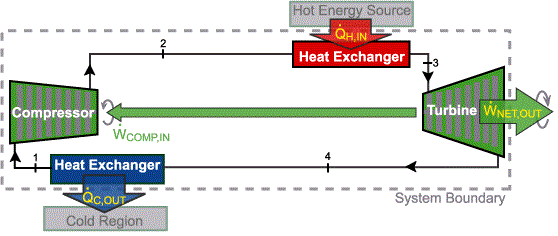Brayton cycle
The Brayton cycle is a thermodynamic cycle used in some heat engines. Notably, it is used for gas turbine engines and some jet engines. The cycle consists of compressing ambient air, mixing the air with fuel, then igniting the mixture, which expands, doing work. In many Brayton cycle engines, the hot air can then be recycled, heating the fresh air coming through. This increases efficiency, because less fuel is needed to heat the fresh air. In physics terms, the cycle consists of adiabatic compression and expansion paired with isobaric heating and cooling, and allows for increased efficiency over some other cycles.[1]

Some designs for nuclear power plants have toyed with the idea of using a Brayton cycle, such as the South African Pebble-bed modular reactor.[3] and certain molten salt reactors. This would require using heated gas from the reactor core to power the turbines. However, the large amount of research and development needed to implement this has so far been a barrier preventing success. The majority of nuclear reactors instead use a Rankine cycle steam engine, so current gas-cooled models must use this heated gas to heat water in turn for the steam engine turbines.
References
- ↑ D. Quattrochi, "Brayton Cycle," 06 August 2006. [Online]. Available: http://web.mit.edu/16.unified/ www/SPRING/propulsion/notes/node27.html. [Accessed 28 March 2013].
- ↑ http://www.wiley.com/college/moran/CL_0471465704_S/user/tutorials/tutorial9/tut9n_content.html
- ↑ A. Koster, R. Matzie and D. Matzner, "Pebble-bed modular reactor: A generation IV high-temperature gas-cooled reactor," Proceedings of the Institustion of Mechanical Engineers, Part A: Journal of Power and Energy, vol. 218, no. 1, pp. 309-318, 2004.

